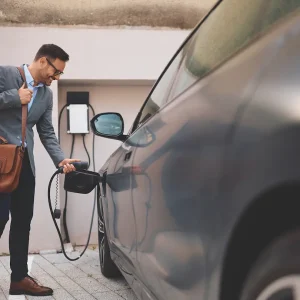Arval employee Dave Pearson swapped his petrol Peugeot 306 for an electric Mitsubishi i-Miev for a year-long trial to see which he preferred. The question is, would he have liked to make the switch a permanent one?
There is no doubt that the Mitsubishi i-Miev electric vehicle saved money compared with my Peugeot 306 (an S-reg 1.6-litre petrol model).
I was previously filling the 306 four times a month at a total cost of around £260. The i-Miev costs less than £1 for a full charge, so despite the fact that it had to be charged every day, the monthly cost was only around £30, which equated to about 1000 miles.
The car is also exempt from the London congestion charge (it has zero tailpipe emissions compared with 170g/km CO2 for my Peugeot). It was significantly cheaper on Vehicle Excise Duty and fell within a cheaper insurance group too.
However, while the running costs are low, that’s not the case for the original purchase price of the i-Miev (£24,000 including a £5000 Government grant). Even with the Government grant factored in, this was still more than most people would spend on a new city car.
While the i-Miev is primarily designed as a city car, the biggest drawback, as with any current electric car, is its range. Although the claimed range is 93 miles, the reality was around 70 miles, especially when I was using auxiliaries like the radio, windscreen wipers, lights and heater. As a result, when the battery began to run low and range anxiety, and therefore stress, increased, things like the air conditioning, the radio and when possible the lights were the first thing to go. This meant that driver comfort would be impacted on longer journeys. I would often complete the outward leg of a journey with no radio or heating so that I could keep charge in reserve to ensure I could get back. At low battery, road works, traffic and diversions became a genuine hazard to completing the journey.
In the early days when I was unsure of the limits of the vehicle, I did feel anxious about running out of charge, although this reduced the more that I used the car. I also found that the battery life indicator could drop swiftly at times especially during seasonal extremes. A full charge from empty would take five hours while a three-hour stint added 75% charge. However, once, when attempting to drive from the Arval office in Birmingham to the firm’s head office in Swindon just over 90 miles away, I had to stop at the Mitsubishi Motors’ UK head office in Cirencester where their supercharger restored 80% charge in 25 minutes.
To support the trial, Arval fitted a charging point at its Birmingham offices and a second point was fitted on my driveway at home. There is also a handy charging point in the car park at the Pallasades shopping centre in the centre of Birmingham but they are by no means widespread.
Performance
The Mitsubishi’s performance was pleasantly surprising. The car wasn’t sluggish at all; in fact, it accelerated very well from 0-50mph and has a top speed of 81mph. The look on the face of some other drivers at traffic lights suggested that they too were surprised with the car’s acceleration! However, driving at 70mph on the motorway drained the battery very quickly.
On the subject of the battery, late in the trial I experienced a couple of battery problems, resulting in the vehicle being absent for three days each time. However, the i-Miev used in the trial was the Japanese specification, which has now been superseded in the UK by an enhanced version. Another absence occurred due to a service, but this was for a day, the same length of time any car would have been off the road.
The battery also impacted boot space, which limited the car’s capacity to carry loads and meant that even if range had allowed, it couldn’t have been used for a holiday. I could just fit the weekly shopping into the boot with a few extra bags on the back seat. On the plus side, this did stop me overloading the vehicle, which affects performance.
The i-Miev holds a four-star EuroNCAP safety rating and from a driver safety point of view, I didn’t have any issues over and above those that you would experience in any other modern car. However, when in proximity to pedestrians it was a slightly different matter: driving an electric car makes a big difference in built-up areas and especially in car parks as people just do not hear you approaching. It requires very careful driving and you have to continually anticipate the risk of people stepping out in front of you. However, driving even more carefully isn’t a bad habit to get into.
In terms of its appearance, my initial thoughts were that I was really pleased that the i-Miev looked like a normal new car and not some kind of science experiment that would stick out on the road. Once I got into it I had a similar view: it was very nice and comparable with any other modern new car.
However, there is no doubt that driving an electric vehicle does provoke a reaction from other drivers, especially when the paintwork highlights the fact that it is electric, and I often saw other drivers doing a double take. But while there was lots of interest from people passing, I never felt uncomfortable or conspicuous.
I also didn’t receive any negative reaction from friends or colleagues to the car. The only thing that caused people to raise an eyebrow was conversations about the capital cost of the vehicle. There was no increase in drivers cutting me up or showing less respect.
On the whole I had a positive experience. Some training on how to adapt your driving style to maximise the performance of an electric car would have been helpful before the trial began, and while I picked up good habits throughout the process – due to paying particular attention to pedestrian safety and because the risk of running out of battery forces you to adopt an efficient driving style – it would have been useful to have this knowledge from the outset.
Would I have liked to replace my Peugeot permanently with the i-Miev? I would happily have kept the car. However, it was a step too far for my wife who wasn’t keen to drive it. Range anxiety was an issue initially and while it did diminish, it never fully went away. However, I learnt to deal with this and altered my driving style accordingly, and in the end I was sorry to hand it back.





